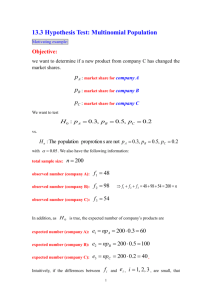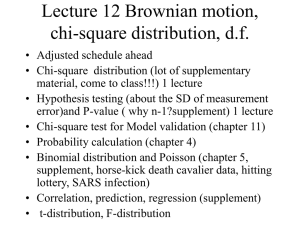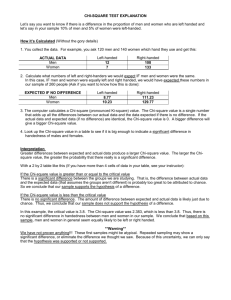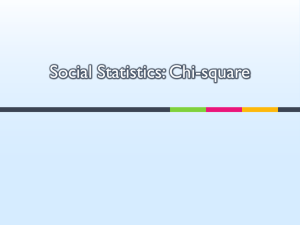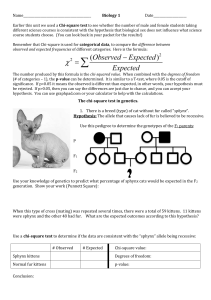Chi-Square Test
advertisement
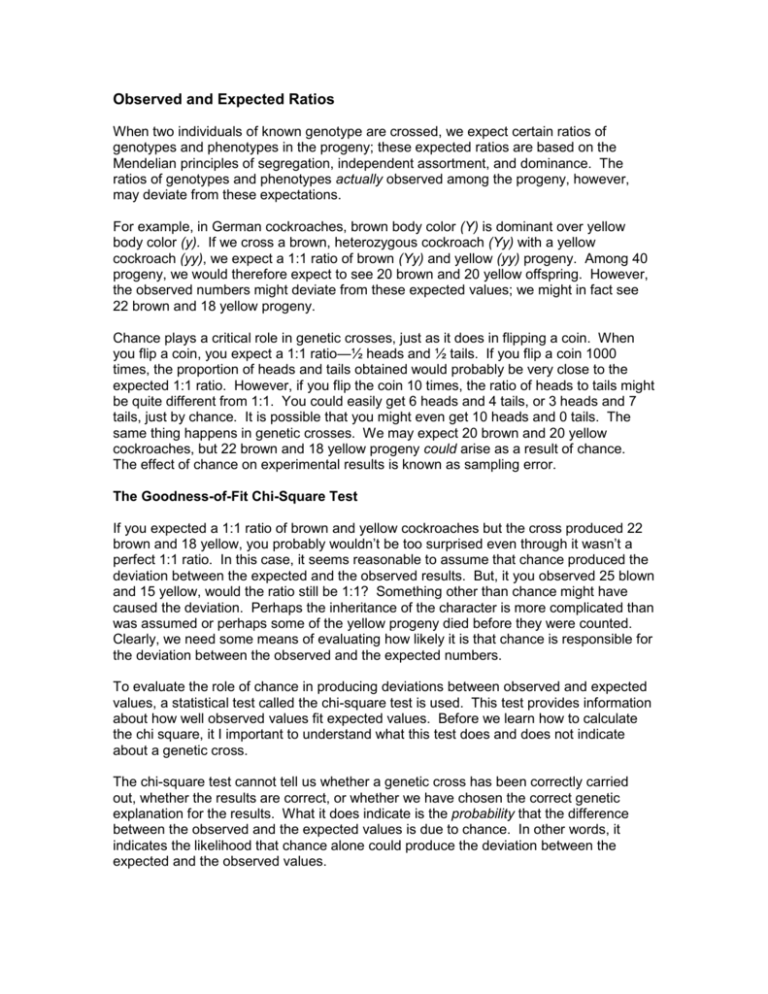
Observed and Expected Ratios When two individuals of known genotype are crossed, we expect certain ratios of genotypes and phenotypes in the progeny; these expected ratios are based on the Mendelian principles of segregation, independent assortment, and dominance. The ratios of genotypes and phenotypes actually observed among the progeny, however, may deviate from these expectations. For example, in German cockroaches, brown body color (Y) is dominant over yellow body color (y). If we cross a brown, heterozygous cockroach (Yy) with a yellow cockroach (yy), we expect a 1:1 ratio of brown (Yy) and yellow (yy) progeny. Among 40 progeny, we would therefore expect to see 20 brown and 20 yellow offspring. However, the observed numbers might deviate from these expected values; we might in fact see 22 brown and 18 yellow progeny. Chance plays a critical role in genetic crosses, just as it does in flipping a coin. When you flip a coin, you expect a 1:1 ratio—½ heads and ½ tails. If you flip a coin 1000 times, the proportion of heads and tails obtained would probably be very close to the expected 1:1 ratio. However, if you flip the coin 10 times, the ratio of heads to tails might be quite different from 1:1. You could easily get 6 heads and 4 tails, or 3 heads and 7 tails, just by chance. It is possible that you might even get 10 heads and 0 tails. The same thing happens in genetic crosses. We may expect 20 brown and 20 yellow cockroaches, but 22 brown and 18 yellow progeny could arise as a result of chance. The effect of chance on experimental results is known as sampling error. The Goodness-of-Fit Chi-Square Test If you expected a 1:1 ratio of brown and yellow cockroaches but the cross produced 22 brown and 18 yellow, you probably wouldn’t be too surprised even through it wasn’t a perfect 1:1 ratio. In this case, it seems reasonable to assume that chance produced the deviation between the expected and the observed results. But, it you observed 25 blown and 15 yellow, would the ratio still be 1:1? Something other than chance might have caused the deviation. Perhaps the inheritance of the character is more complicated than was assumed or perhaps some of the yellow progeny died before they were counted. Clearly, we need some means of evaluating how likely it is that chance is responsible for the deviation between the observed and the expected numbers. To evaluate the role of chance in producing deviations between observed and expected values, a statistical test called the chi-square test is used. This test provides information about how well observed values fit expected values. Before we learn how to calculate the chi square, it I important to understand what this test does and does not indicate about a genetic cross. The chi-square test cannot tell us whether a genetic cross has been correctly carried out, whether the results are correct, or whether we have chosen the correct genetic explanation for the results. What it does indicate is the probability that the difference between the observed and the expected values is due to chance. In other words, it indicates the likelihood that chance alone could produce the deviation between the expected and the observed values. If we expected 20 brown and 20 yellow progeny from a genetic cross, the chi-square test gives the probability that we might observe 25 brown and 15 yellow progeny simply due to chance deviations from the expected 20:20 ratio. When the probability calculated from the chi-square test is high, we assume that chance alone produced the difference. When the probability is low, we assume that some factor other than chance—some significant factor—produced the deviation. To use the chi-square test, we first determine the expected results. The chi-square test must always be applied to numbers of progeny, not to proportion or percentages. Let’s consider a locus for coat color in domestic cats, for which black color (B) is dominant over gray (b). If we crossed two heterozygous black cats (Bb X Bb), we would expect a 3:1 ratio of black and gray kittens. A series of such crosses yields a total of 50 kittens—30 black and 20 gray. These numbers are our observed values. We can obtain the expected numbers by multiplying the expected proportions by the total number of observed progeny. In this case, the expected number of black kittens is ¾ X 50 = 37.5 and the expected number of gray kittens is ¼ X 50 = 12.5. The chi-square value (is calculated by using the following formula: observedexpected)expected Where means the sum of all the squared differences between observed and expected divided by the expected values. To calculate the chi-square value for our black and gray kittens, we would first subtract the number of expected black kittens from the number of observed black kittens (30 – 37.5 = -7.5) and square this value: -7.52 = 56.25. We then divide this result by the expected number of black kittens, 56.25/37.5 = 1.5. We repeat the calculations on the number of expected gray kittens: (20 – 12.5)2/12.5 = 4.5. To obtain the overall chi-square value, we sum the (observed – expected) 2/expected values: 1.5 + 4.5 = 6.0. The next step is to determine the probability associated with this calculated chi-square value, which is the probability that the deviation between the observed and the expected results could be due to chance. This step requires us to compare the calculated chisquare value (6.0) with theoretical values that have the same degrees of freedom in a chi-square table. The degrees of freedom represent the number of ways in which the observed classes are free to vary. For a chi-square test, the degrees of freedom are equal to n -1, where n is the number of different expected phenotypes. In our example, there are two expected phenotypes (black and gray), so n = 2 and the degree of freedom equals 2 -1 = 1. Now that we have our calculated chi-square value and have figured out the associated degrees of freedom, we are ready to find the probability from a chi-square table. The degrees of freedom are given in the left-hand column of the table and the probabilities are given at the top; within the body of the table are chi-square values associated with these probabilities. First, find the row for the appropriate degrees of freedom; for our example with 1 degree of freedom, it is the first row of the table. Then find where our calculated chi-square value (6.0) lies among the theoretical values in this row. The theoretical chi-square values increase from left to right and the probabilities decrease from left to right. Our chi-square value of 6.0 falls between the value of 5.024, associated with the probability of .025, and the value of 6.635, associated with a probability of .01. 2 So, the probability associated with our chi-square value is less than .025 and greater than .01. In other words, there is less than a 2.5% probability that the expected and the observed numbers of black and gray kittens were so different simply by chance. Most scientists use the .05 probability level as their cutoff value: if the probability of chance being responsible for the deviation is greater than or equal to .05, they accept that chance may be responsible for the deviation between the observed and the expected values. When the probability is less than .05, scientists assume that chance is not responsible and a significant difference exists. The expression significant difference means that some factor other than chance is responsible for the observed values being different from the expected values. In regard to the kittens, perhaps one of the genotypes experienced increased mortality before the progeny were counted or perhaps other genetic factors skewed the observed ratios. In choosing .05 as the cutoff value, scientists have agreed to assume that chance is responsible for the deviation between observed and expected values unless there is strong evidence to the contrary. It is important to bear in mind that even if we obtain a probability of, say .01, there is still a 1% probability that the deviation between the observed and expected numbers is due to nothing more than chance. From: Pierce, B.A. (20053) Genetics: a conceptual approach. W. W. Freeman and Company. 3



